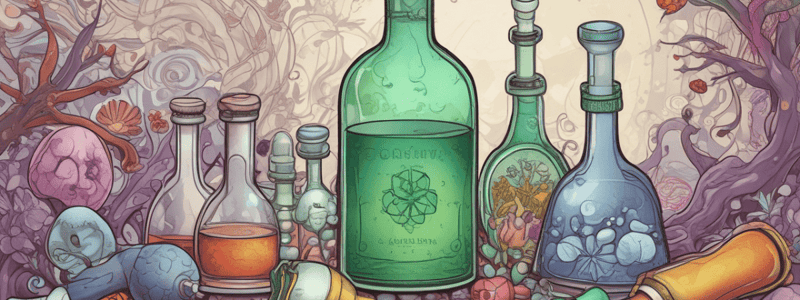Podcast
Questions and Answers
Amantadine enhances the release of which neurotransmitter and prevents its reuptake?
Amantadine enhances the release of which neurotransmitter and prevents its reuptake?
- Acetylcholine
- GABA
- Serotonin
- Dopamine (correct)
Why is dialysis not effective in eliminating amantadine?
Why is dialysis not effective in eliminating amantadine?
- Due to its large volume of distribution (correct)
- Because of its rapid clearance
- Because of its high degree of protein binding
- Due to its low molecular weight
Which of the following is NOT a clinical presentation of amantadine toxicity?
Which of the following is NOT a clinical presentation of amantadine toxicity?
- Delirium
- Agitation
- Visual hallucinations
- Hypothermia (correct)
What is the typical treatment approach for amantadine toxicity?
What is the typical treatment approach for amantadine toxicity?
What is the significance of serum levels above 1.5mg/L in amantadine toxicity?
What is the significance of serum levels above 1.5mg/L in amantadine toxicity?
Which group of patients is more prone to developing toxic intoxication with therapeutic doses of amantadine?
Which group of patients is more prone to developing toxic intoxication with therapeutic doses of amantadine?
What is a possible complication of amantadine withdrawal?
What is a possible complication of amantadine withdrawal?
What is a characteristic anticholinergic manifestation of amantadine toxicity?
What is a characteristic anticholinergic manifestation of amantadine toxicity?
What laboratory study is useful in evaluating amantadine toxicity?
What laboratory study is useful in evaluating amantadine toxicity?
What is the minimum toxic dose of quinine in adults?
What is the minimum toxic dose of quinine in adults?
What is the fatal dose of quinine in children?
What is the fatal dose of quinine in children?
What is cinchonism?
What is cinchonism?
When does retinal toxicity typically occur after quinine ingestion?
When does retinal toxicity typically occur after quinine ingestion?
What is the purpose of a stellate ganglion block?
What is the purpose of a stellate ganglion block?
What is the recommended dose of hypertonic sodium bicarbonate for cardiotoxicity?
What is the recommended dose of hypertonic sodium bicarbonate for cardiotoxicity?
What is the common feature of severe quinine intoxication?
What is the common feature of severe quinine intoxication?
What is the laboratory study that is NOT mentioned in the content?
What is the laboratory study that is NOT mentioned in the content?
What is the purpose of decontamination in quinine overdose?
What is the purpose of decontamination in quinine overdose?
What is the name of the enzyme that helps protect red blood cells from destruction?
What is the name of the enzyme that helps protect red blood cells from destruction?
What is a common side effect of primaquine and quinacrine intoxication?
What is a common side effect of primaquine and quinacrine intoxication?
What is the therapeutic dose of chloroquine phosphate for malaria prophylaxis?
What is the therapeutic dose of chloroquine phosphate for malaria prophylaxis?
What is the estimated lethal dose of chloroquine for adults?
What is the estimated lethal dose of chloroquine for adults?
What is a common laboratory study used to evaluate chloroquine toxicity?
What is a common laboratory study used to evaluate chloroquine toxicity?
What is a characteristic symptom of mild to moderate chloroquine overdose?
What is a characteristic symptom of mild to moderate chloroquine overdose?
What is a complication of chloroquine use in G6PD-deficient patients?
What is a complication of chloroquine use in G6PD-deficient patients?
What is a side effect of mefloquine use?
What is a side effect of mefloquine use?
What is a characteristic laboratory finding in primaquine or quinacrine intoxication?
What is a characteristic laboratory finding in primaquine or quinacrine intoxication?
What is the therapeutic range for the drug mentioned in the text?
What is the therapeutic range for the drug mentioned in the text?
What is the primary mechanism of action for methylene blue in the treatment of methemoglobinemia?
What is the primary mechanism of action for methylene blue in the treatment of methemoglobinemia?
Which of the following is a characteristic of sulfhemoglobinemia?
Which of the following is a characteristic of sulfhemoglobinemia?
What is the primary treatment for the condition mentioned in the text?
What is the primary treatment for the condition mentioned in the text?
What is a characteristic of hemolysis in the context of the provided text?
What is a characteristic of hemolysis in the context of the provided text?
Which of the following is a potential complication of the condition discussed in the text?
Which of the following is a potential complication of the condition discussed in the text?
What is the significance of Heinz bodies in the context of the text?
What is the significance of Heinz bodies in the context of the text?
What is the recommended prehospital treatment for the condition mentioned in the text?
What is the recommended prehospital treatment for the condition mentioned in the text?
Which of the following statements accurately describes the condition's effect on oxyhemoglobin saturation?
Which of the following statements accurately describes the condition's effect on oxyhemoglobin saturation?
Which of the following is a possible symptom of an acute overdose of a drug mentioned in the content?
Which of the following is a possible symptom of an acute overdose of a drug mentioned in the content?
What drug is commonly used to treat methemoglobinemia caused by dapsone overdose?
What drug is commonly used to treat methemoglobinemia caused by dapsone overdose?
Which of the following enzymes is inhibited by trimethoprim?
Which of the following enzymes is inhibited by trimethoprim?
Which of the following drugs is indicated for the treatment of leprosy?
Which of the following drugs is indicated for the treatment of leprosy?
Which of the following statements about dapsone is TRUE?
Which of the following statements about dapsone is TRUE?
Which of the following drugs inhibits the enzyme dihydropteroate synthase?
Which of the following drugs inhibits the enzyme dihydropteroate synthase?
What is the recommended treatment for a patient who has overdosed on dapsone and is experiencing methemoglobinemia?
What is the recommended treatment for a patient who has overdosed on dapsone and is experiencing methemoglobinemia?
What is the primary reason why leucovorin is administered in cases of drug overdose?
What is the primary reason why leucovorin is administered in cases of drug overdose?
Which of the following statements regarding the toxic dose of drugs mentioned in the content is TRUE?
Which of the following statements regarding the toxic dose of drugs mentioned in the content is TRUE?
Flashcards are hidden until you start studying
Study Notes
Toxic Dose Overview
- Toxic doses vary significantly among individuals, highlighting the need for caution.
- Leucovorin, a folic acid analog, is administered intravenously post-overdose to restore normal folate levels.
- Life-threatening reactions can occur even at subtherapeutic doses in sensitive individuals.
Clinical Presentations of Overdose
- Acute overdose symptoms typically include nausea, vomiting, and diarrhea.
- Dapsone overdose requires methylene blue for treating symptomatic methemoglobinemia.
- Chronic dapsone use can lead to methemoglobin levels of 5-8%, with life-threatening doses exceeding 1.4g.
- Sulfhemoglobinemia, a rare condition, results in excess sulfhemoglobin in the blood, causing cyanosis and unresponsiveness to methylene blue.
Diagnostic Considerations
- Diagnosis relies on patient history and clinical symptoms; specific drug levels are often not available.
- For toxic doses, serum levels greater than 1.5 mg/L indicate potential poisoning.
- Additional lab tests include electrolytes, BUN, creatinine, and ECG monitoring.
Treatment Approaches
- Emergency care includes administering activated charcoal and supportive measures.
- Methylene blue is pivotal for methemoglobinemia.
- Antidotes are mostly unavailable for other toxicities.
Mechanism of Toxicity
- Amantadine enhances dopamine release and inhibits its reuptake, affecting both peripheral and central nervous systems.
- High degrees of protein binding in certain drugs hinder their removal by hemodialysis.
Clinical Manifestations of Amantadine Toxicity
- Symptoms may include agitation, hallucinations, tremors, slurred speech, and dysautonomia.
- Withdrawal can precipitate hyperthermia and rigidity.
Additional Toxicity Discussion
- Quinine overdose can induce mild symptoms like nausea and severe reactions including respiratory arrest and cardiotoxicity.
- Symptoms of quinine-induced blindness appear 9-10 hours post-ingestion, accompanied by retinal toxicity.
Diagnosis and Treatment for Quinine Overdose
- Diagnosis through history and symptoms; drug levels can be checked, although not often readily available.
- Treatment involves hypertonic sodium bicarbonate for cardiotoxicity and activated charcoal for decontamination.
Specific Drug Information
- Primaquine and quinacrine overdoses lead to gastrointestinal upset, methemoglobinemia, and potential severe hemolysis.
- Chloroquine has a therapeutic range with risks of severe toxicity at doses above 30-50 mg/kg in adults, with reported pediatric fatalities at 300 mg.
General Precautions and Measures
- Emergency interventions are critical in cases of suspected toxicity.
- Regular monitoring of electrolyte levels and other relevant laboratory parameters is essential for patient safety and effective management.
Studying That Suits You
Use AI to generate personalized quizzes and flashcards to suit your learning preferences.



